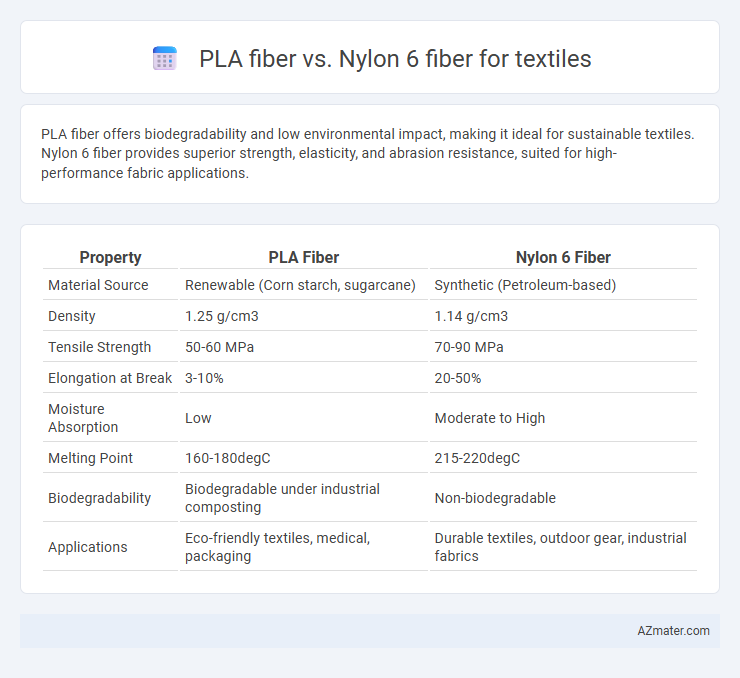PLA fiber offers biodegradability and low environmental impact, making it ideal for sustainable textiles. Nylon 6 fiber provides superior strength, elasticity, and abrasion resistance, suited for high-performance fabric applications.
Table of Comparison
| Property | PLA Fiber | Nylon 6 Fiber |
|---|---|---|
| Material Source | Renewable (Corn starch, sugarcane) | Synthetic (Petroleum-based) |
| Density | 1.25 g/cm3 | 1.14 g/cm3 |
| Tensile Strength | 50-60 MPa | 70-90 MPa |
| Elongation at Break | 3-10% | 20-50% |
| Moisture Absorption | Low | Moderate to High |
| Melting Point | 160-180degC | 215-220degC |
| Biodegradability | Biodegradable under industrial composting | Non-biodegradable |
| Applications | Eco-friendly textiles, medical, packaging | Durable textiles, outdoor gear, industrial fabrics |
Introduction to PLA Fiber and Nylon 6 Fiber
PLA fiber, derived from renewable resources like corn starch, offers biodegradability and eco-friendly advantages in textile manufacturing. Nylon 6 fiber, a synthetic polymer made from caprolactam, is renowned for its high tensile strength, durability, and excellent abrasion resistance. Both fibers serve distinct applications, with PLA focusing on sustainable textiles and Nylon 6 excelling in performance-driven apparel and industrial fabrics.
Chemical Composition and Structure Comparison
PLA fiber is derived from polylactic acid, a biodegradable polyester synthesized from renewable resources like corn starch, featuring a linear aliphatic polyester structure with ester functional groups. Nylon 6 fiber, a synthetic polyamide, consists of repeated units of caprolactam with amide linkages, forming a semi-crystalline structure with strong hydrogen bonding that contributes to high tensile strength. The chemical composition and hydrogen bonding in Nylon 6 lead to superior moisture absorption and durability, while PLA fibers exhibit biodegradability and lower environmental impact due to their renewable origin and hydrolyzable ester bonds.
Manufacturing Processes of PLA and Nylon 6 Fibers
PLA fiber manufacturing involves the fermentation of renewable resources like corn starch or sugarcane to produce lactic acid, which is then polymerized into polylactic acid and spun into fibers through melt spinning or wet spinning processes. Nylon 6 fiber is produced via ring-opening polymerization of caprolactam, followed by melt spinning to form continuous filaments with high tensile strength and abrasion resistance. Both fibers require controlled temperature and mechanical stretching during spinning to optimize molecular orientation and fiber properties for textile applications.
Environmental Impact and Biodegradability
PLA fiber, derived from renewable resources like cornstarch, offers superior biodegradability compared to Nylon 6 fiber, which is petroleum-based and has a prolonged decomposition timeline in landfills. The production of PLA fiber generates lower greenhouse gas emissions and consumes less energy, contributing to a reduced environmental footprint relative to Nylon 6. While Nylon 6 provides durability and strength, its synthetic nature results in microplastic pollution and challenges in waste management, making PLA a more sustainable option for eco-conscious textile applications.
Mechanical Properties: Strength, Elasticity, and Durability
PLA fiber exhibits moderate tensile strength and high elasticity, making it suitable for lightweight textile applications, while Nylon 6 fiber demonstrates superior strength and higher durability with excellent abrasion resistance. Nylon 6's mechanical properties include better impact resistance and return to original shape after deformation, enhancing its performance in demanding textile uses. PLA fiber biodegradability contrasts with Nylon 6's chemical resistance, influencing long-term durability under various environmental conditions.
Moisture Absorption and Comfort in Textiles
PLA fiber exhibits significantly higher moisture absorption compared to Nylon 6 fiber, enhancing its breathability and comfort in textile applications. PLA's ability to absorb moisture helps in regulating body temperature and reduces sweat accumulation, making it suitable for activewear and casual clothing. In contrast, Nylon 6 fiber has lower moisture absorption, which can lead to less comfort in humid conditions but offers greater durability and quick-drying properties.
Dyeability and Color Fastness
PLA fibers exhibit superior dyeability compared to Nylon 6 fibers due to their amorphous structure, allowing for vibrant and uniform color uptake in textile applications. However, Nylon 6 fibers demonstrate better color fastness, resisting fading and washout under exposure to light, heat, and laundering processes. Textile manufacturers often balance PLA's eco-friendly biodegradability with Nylon 6's durability and long-lasting color retention when selecting fibers for performance and aesthetic requirements.
Cost, Availability, and Scalability
PLA fiber, derived from renewable resources like corn starch, offers cost advantages due to its biodegradable nature and growing demand in sustainable textiles, though its price remains slightly higher than Nylon 6. Nylon 6 fibers, produced from petrochemicals, benefit from well-established global manufacturing infrastructure, ensuring widespread availability and consistent supply at competitive costs. Scalability favors Nylon 6 because of mature mass-production processes, while PLA fiber scalability is improving but still constrained by raw material sourcing and current industrial capacity limitations.
Applications in Textile Industry
PLA fiber, derived from renewable resources like corn starch, offers excellent moisture-wicking and biodegradability, making it ideal for sustainable activewear and eco-friendly fashion textiles. Nylon 6 fiber provides superior strength, elasticity, and abrasion resistance, commonly used in performance garments, hosiery, and industrial textiles requiring durability. The choice between PLA and Nylon 6 depends on balancing environmental impact with mechanical properties for specific textile applications.
Future Trends and Innovations
PLA fiber exhibits significant potential in textile applications due to its biodegradability and sustainable production from renewable resources, positioning it as a key material in eco-friendly fashion trends. Innovations in PLA fiber focus on enhancing its mechanical properties, moisture management, and blend compatibility to compete with traditional Nylon 6 fibers, which remain favored for their durability and elasticity. Future trends indicate increasing investment in bio-based polymer technology and advanced spinning techniques, aiming to reduce the environmental impact of synthetic fibers while maintaining performance standards crucial for textiles.

Infographic: PLA fiber vs Nylon 6 fiber for Textile
 azmater.com
azmater.com